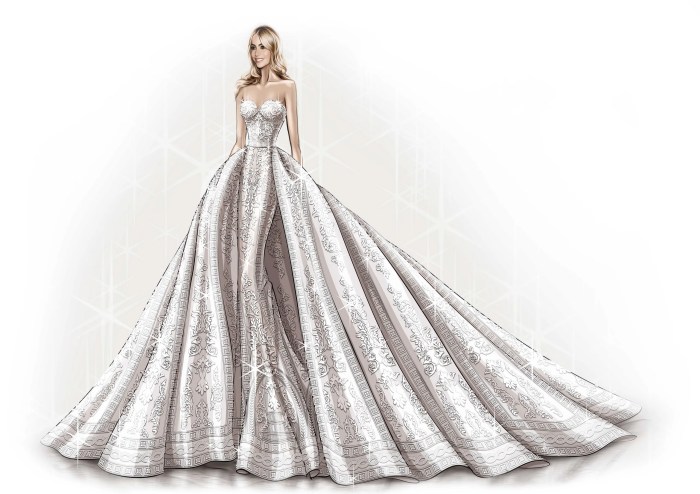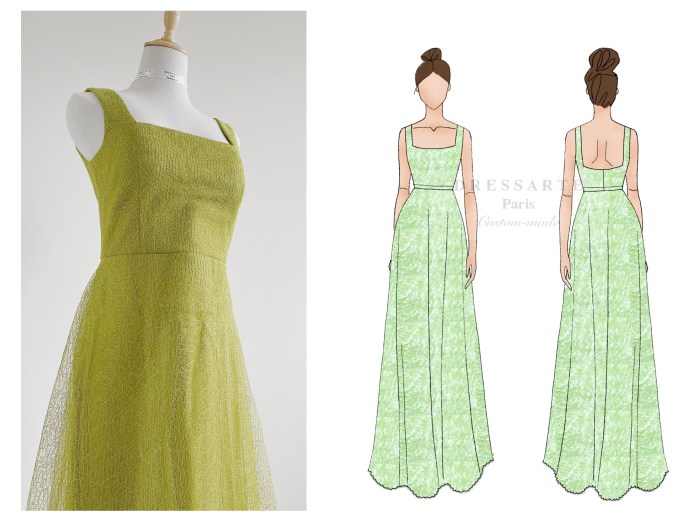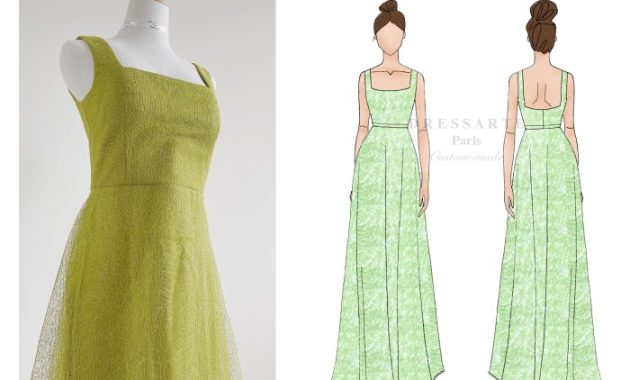The Online Custom Wedding Dress Market
Custom wedding dress online – The market for online custom wedding dresses is experiencing significant growth, driven by a desire for personalization and unique style, alongside the convenience of online shopping. This burgeoning industry caters to a diverse clientele with varying needs and preferences. This article will delve into the key aspects of this market, from understanding the consumer base to navigating the design process and ensuring a positive customer experience.
Online Custom Wedding Dress Demographics and Motivations
The typical online custom wedding dress buyer is often a millennial or Gen Z bride, tech-savvy and comfortable with online transactions. They are typically looking for a unique dress that reflects their personal style and doesn’t conform to traditional bridal shop offerings. Key motivations include the ability to design a completely bespoke gown, access to a wider variety of styles and designers, and often, a more affordable price point compared to traditional boutiques.
Price Comparison: Online Custom vs. Ready-Made

Source: vogue.com
Online custom wedding dresses offer a range of price points, often competitive with or even lower than ready-made gowns from traditional bridal shops, depending on fabric choices and design complexity. Ready-made dresses, while potentially cheaper upfront, lack the personalization of a custom design. The price of an online custom dress can vary significantly based on the designer, fabric selection, and level of embellishment.
Online Platforms for Custom Wedding Dresses
The online landscape for custom wedding dresses is diverse, encompassing independent designers with Etsy shops, large e-commerce platforms specializing in bridal wear, and dedicated websites offering bespoke design services. The table below categorizes some examples:
| Platform Name | Price Range | Customization Options | Customer Reviews Summary |
|---|---|---|---|
| Etsy (Independent Designers) | Varies widely, from $500 to $10,000+ | High level of customization, often direct communication with designer | Mixed reviews; positive feedback on unique designs and personalized service, but some negative experiences with shipping and communication |
| [Large E-commerce Site Example] | Mid-range to high-end | Moderate customization options, pre-selected fabrics and designs | Generally positive reviews, praising ease of use and selection, but some concerns about sizing accuracy |
| [Dedicated Bespoke Website Example] | High-end | Extensive customization, virtual consultations, and detailed design process | Positive reviews highlighting exceptional quality and personalized service, but higher price point may be a deterrent for some |
The Custom Design Process
Designing a custom wedding dress online typically involves several key steps. A clear understanding of these steps is crucial for a positive experience. This section Artikels the typical process and design elements involved.
Steps in Online Custom Dress Design
The process generally begins with an initial consultation, either through email, video call, or online questionnaires. This allows the designer to understand the bride’s vision, body measurements, and preferences. Next, sketches and design mockups are created, followed by fabric selection and detailed measurements. Once the design is finalized, the dress is constructed and shipped to the bride.
Final fittings may be offered, depending on the platform.
Customizable Design Elements
Brides can customize numerous aspects, including silhouette (A-line, mermaid, ballgown), neckline (sweetheart, V-neck, halter), sleeve style (sleeveless, long sleeves, off-the-shoulder), fabric (lace, silk, satin), embellishments (beading, embroidery, appliqués), and train length (chapel, cathedral, sweep).
Examples of Successful Custom Designs
Example 1: A bride chose a sleek, minimalist A-line silhouette in ivory silk crepe, complemented by delicate spaghetti straps and a subtle train. The simplicity of the design allowed the high-quality fabric to shine. Example 2: A romantic ballgown in embroidered tulle featured a sweetheart neckline, off-the-shoulder sleeves, and intricate floral appliqués. The combination of tulle and embroidery created a dreamy, ethereal look.
Example 3: A modern sheath dress in bold patterned lace with a high neckline and a short train provided a unique and sophisticated style.
Custom Wedding Dress Mock-up Sketches, Custom wedding dress online
Below are descriptions of three mock-up sketches, highlighting design choices and their impact on the overall look:
- Bohemian Lace Gown: A flowing A-line silhouette in chantilly lace, featuring a delicate V-neckline, three-quarter sleeves, and a subtle train. Delicate floral embroidery adds a touch of romance. The lace’s intricate details and soft drape create a relaxed, yet elegant aesthetic.
- Modern Minimalist Satin Dress: A sleek sheath dress in luxurious ivory satin, featuring a high neckline, long sleeves, and a short train. Minimal embellishments allow the satin’s sheen and drape to take center stage, creating a sophisticated and timeless look.
- Romantic Tulle Ballgown: A classic ballgown silhouette in soft tulle, with a sweetheart neckline, off-the-shoulder sleeves, and a cathedral train. Intricate beading and embroidery along the bodice and skirt create a luxurious and romantic feel. The tulle’s airy texture and the embellishments create a dreamy, fairytale-like appearance.
Fabric and Materials
The choice of fabric significantly impacts the look, feel, and overall cost of a custom wedding dress. Understanding the properties of different fabrics is essential for making informed decisions.
Common Wedding Dress Fabrics and Their Properties
Common fabrics include silk (luxurious, drapes well, expensive), satin (shiny, smooth, less breathable), crepe (matte, structured, wrinkle-resistant), tulle (airy, sheer, delicate), lace (intricate patterns, can be delicate), organza (crisp, sheer, holds structure), and chiffon (lightweight, flowing, drapes beautifully).
Advantages and Disadvantages of Fabrics for Online Customization
Some fabrics, like silk, may be more challenging to work with remotely due to their delicate nature. Others, like crepe, are more forgiving and easier to manage in online customization. The ease of working with a particular fabric online may influence the designer’s recommendations.
Sustainability and Ethical Sourcing
Increasingly, brides prioritize sustainable and ethically sourced fabrics. Many online platforms offer options made from organic cotton, recycled materials, or sustainably harvested silk. Transparency regarding fabric sourcing is becoming a key factor in choosing an online provider.
Unique Fabric Combinations
- Silk charmeuse bodice with tulle skirt: Creates a luxurious contrast of smooth and airy textures.
- Lace overlay on crepe: Adds delicate detail to a structured silhouette.
- Satin and embroidered lace: Combines the shine of satin with the intricate details of lace.
- Organza and chiffon: Creates a layered, flowing effect with varying levels of sheerness.
- Crepe and beaded tulle: A sophisticated combination of structured and embellished textures.
Sizing and Fit for Online Custom Dresses
Accurate sizing and fit are crucial for a successful online custom wedding dress experience. This section Artikels methods used to ensure proper fit and addresses potential challenges.
Methods for Ensuring Accurate Sizing and Fit

Source: dressarteparis.com
Online platforms utilize detailed measurement guides, virtual consultations, and sometimes sample sizes to ensure accurate sizing. They may also offer alterations or adjustments to accommodate minor discrepancies.
Challenges and Solutions Related to Online Sizing
Challenges include variations in body shape and measurements, and the inability to physically try on the dress before purchase. Solutions include providing comprehensive measurement guides, offering virtual consultations with stylists, and clear return/alteration policies.
Influence of Body Type on Design and Fit
Different body types require different design considerations to ensure a flattering and comfortable fit. For example, an A-line silhouette is generally flattering on most body types, while a mermaid style may be better suited for hourglass figures.
Step-by-Step Guide to Taking Body Measurements
- Bust: Measure around the fullest part of your bust, keeping the tape measure level.
- Waist: Measure around your natural waistline, the narrowest part of your torso.
- Hips: Measure around the fullest part of your hips, keeping the tape measure level.
- Hollow to Hem: Measure from the hollow of your throat (where your collarbone meets) to the desired length of your dress.
- Shoulder to Waist: Measure from your shoulder point to your natural waistline.
- Shoulder to Bust: Measure from your shoulder point to the fullest part of your bust.
- Arm Length: Measure from your shoulder point to your wrist.
- Bicep: Measure the circumference of your upper arm at its thickest point.
Customer Experience and Reviews: Custom Wedding Dress Online
Analyzing customer experiences and reviews provides valuable insights into the strengths and weaknesses of online custom wedding dress services.
Positive and Negative Customer Experiences
Positive reviews often highlight the unique designs, personalized service, and affordability. Negative reviews frequently mention delays in delivery, communication issues, sizing discrepancies, or quality control problems.
Common Customer Issues
Common issues include delays due to production times or shipping, communication breakdowns between the bride and designer, and discrepancies between the final dress and the initial design or measurements.
Strategies for Improving Customer Experience
Strategies include improving communication channels, streamlining the design and production process, offering more comprehensive sizing guides and virtual consultations, and providing clear return/alteration policies.
Categorized Customer Reviews
| Review Source | Review Sentiment | Key Issues Mentioned | Overall Rating |
|---|---|---|---|
| [Review Platform Example 1] | Positive | Beautiful dress, excellent communication with designer | 5 stars |
| [Review Platform Example 2] | Negative | Significant delay in delivery, sizing issues | 1 star |
| [Review Platform Example 3] | Neutral | Dress was as expected, but minor alterations needed | 3 stars |
FAQ Compilation
How long does it typically take to receive a custom wedding dress online?
Lead times vary greatly depending on the designer and the complexity of the design, but typically range from 4 to 8 months. Always confirm the estimated delivery date with the vendor before placing your order.
What happens if my custom dress doesn’t fit perfectly?
Reputable online platforms offer alteration services or detailed return/exchange policies. Always review the vendor’s policy before ordering and ensure you accurately follow their measurement guidelines.
Can I make changes to my design after the order is placed?
Designing your custom wedding dress online offers unparalleled personalization. For inspiration, consider the flattering silhouette of a bustier wedding guest dress , which showcases a structured bodice. This style could influence the design of your own custom gown, offering a sophisticated and elegant look for your special day. Ultimately, the freedom of a custom design allows you to create a truly unique and unforgettable wedding dress.
Most designers allow for minor adjustments, but significant changes after the initial design approval may incur additional costs or delays. It’s best to finalize the design before placing your order.
What payment methods are typically accepted for online custom wedding dresses?
Most online platforms accept major credit cards, debit cards, and sometimes PayPal. Some may also offer financing options. Always check the vendor’s accepted payment methods before ordering.

